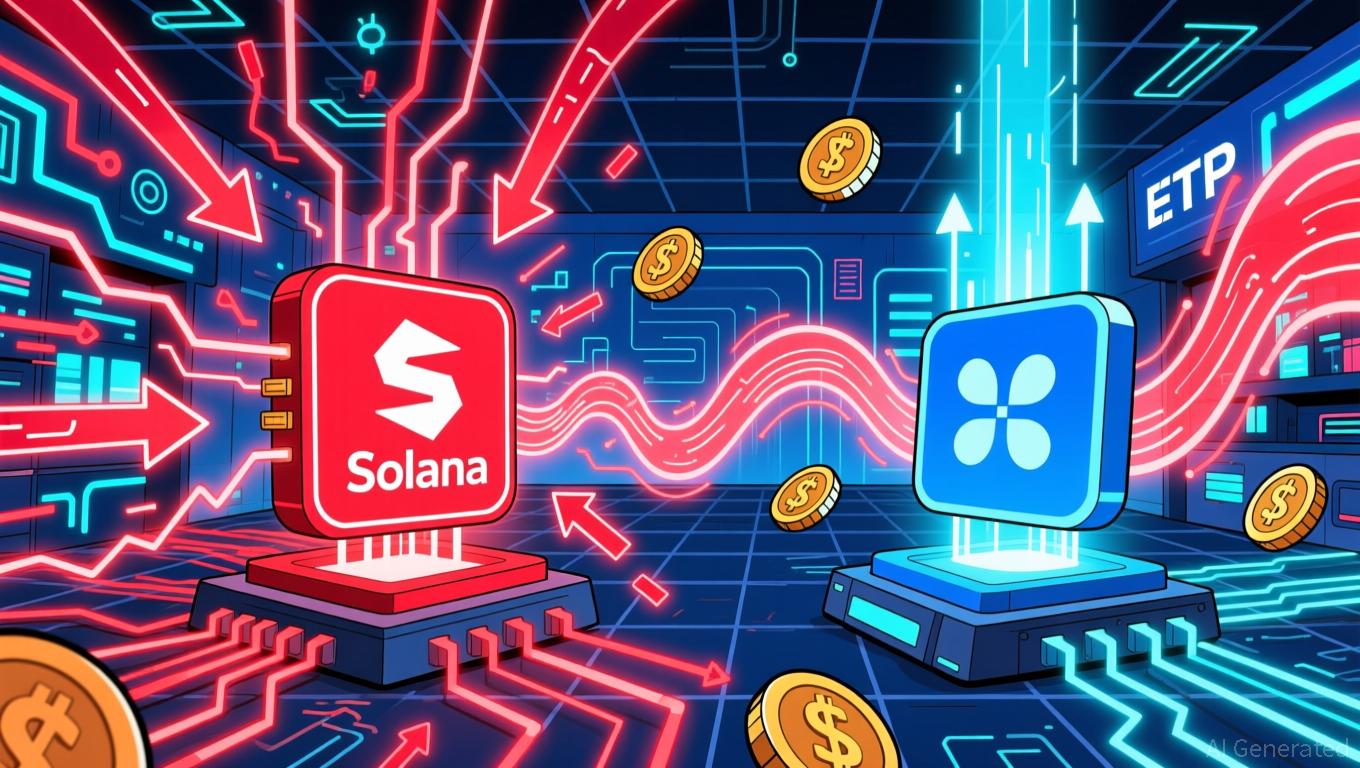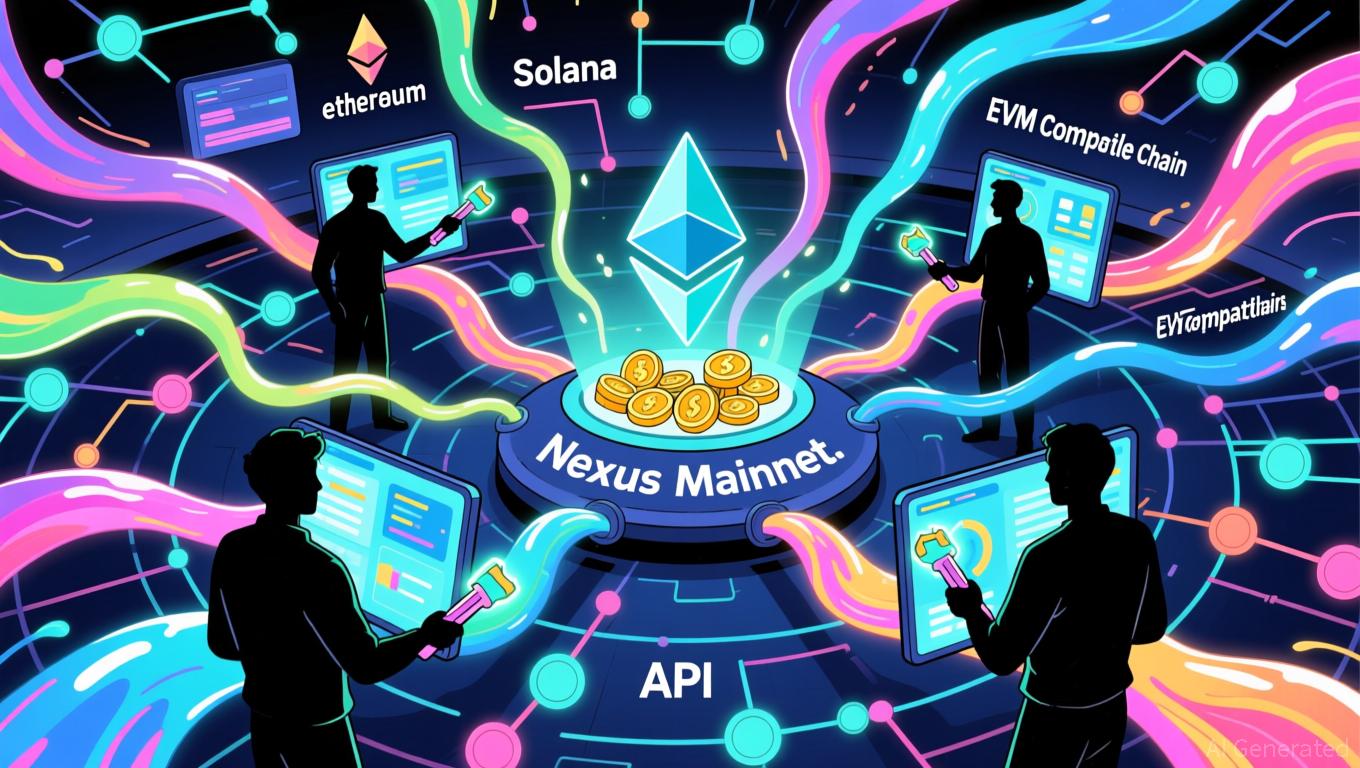Solana News Update: Investors Shift Toward XRP ETFs, Bringing Solana's 21-Day Inflow Streak to a Close
- Solana ETFs ended a 21-day inflow streak with a $8.1M net outflow on Nov 27, 2025, led by 21Shares TSOL's $34.37M redemptions. - This reversal contrasted with Bitcoin/Ethereum ETFs' $5.43B outflows and highlighted Solana's 7% staking yields and 70M daily transactions. - Analysts linked the shift to profit-taking, macroeconomic pressures, and investor rotation toward XRP ETFs with perfect inflow records. - Despite the outflow, Solana ETFs still hold $964M in assets, but face challenges as TVL dropped 32%
Solana ETF Inflow Streak Ends Amid Market Turbulence
Solana (SOL) exchange-traded funds, once a beacon of institutional optimism for the blockchain, saw their impressive streak of daily inflows come to a halt on November 27, 2025. On that day, Solana ETFs experienced their first net outflow, totaling $8.1 million, after 21 consecutive sessions of positive inflows. This reversal was largely attributed to the 21Shares Solana ETF (TSOL), which faced $34.37 million in redemptions, pushing the sector into negative territory. Despite this setback, other Solana ETFs, such as Bitwise's BSOL and Grayscale's GSOL, continued to attract investor capital, helping to cushion the overall outflow.
The abrupt end to Solana's inflow streak highlights the increasing volatility within the crypto ETF sector. Since their inception, Solana ETFs had managed to defy broader market declines, amassing $568 million in net inflows. However, the recent outflow has exposed the fragility of investor confidence. The TSOL fund, now holding $86 million in net assets after cumulative outflows of $26 million, became the focal point of this shift. Experts point to a mix of profit-taking, macroeconomic uncertainty, and a rotation of funds toward other assets—such as XRP ETFs, which have maintained a flawless inflow record since launching on November 14—as key drivers behind the change.

Solana ETFs have outperformed their Bitcoin and Ethereum counterparts, which have struggled in recent months. In November alone, Bitcoin ETFs saw $3.79 billion in outflows, while Ethereum ETFs lost $1.64 billion. In contrast, Solana funds attracted $414 million during the same period. This resilience was supported by competitive fees, staking yields reaching up to 7%, and strong institutional interest in Solana's high transaction throughput—reportedly processing 70 million transactions daily. Nevertheless, the latest outflow suggests that even robust fundamentals may not fully insulate Solana from broader market anxieties.
Investors are now closely monitoring the situation for signs of stabilization. Despite the $8.1 million outflow, Solana ETFs still manage $964 million in assets, representing 1.15% of the blockchain's $79 billion market capitalization. Meanwhile, XRP ETFs have surged, accumulating $643 million in inflows without a single day of net outflows. In contrast, Dogecoin ETFs have underperformed, with Grayscale's GDOG ETF recording only $1.4 million in trading volume on its first day.
The contrasting performances among crypto ETFs reflect shifting institutional preferences. While Solana's total value locked has dropped by 32% since September, indicating some bearish sentiment, continued ETF inflows suggest ongoing faith in the blockchain's long-term potential. As markets contend with uncertainty around Federal Reserve policy and rising interest rates, the coming weeks will reveal whether Solana's institutional support can persist or if the recent outflow marks the start of a broader reassessment of risk. For now, the story of Solana ETFs encapsulates the ongoing tension between innovation and volatility in the cryptocurrency sector.
Disclaimer: The content of this article solely reflects the author's opinion and does not represent the platform in any capacity. This article is not intended to serve as a reference for making investment decisions.
You may also like
Ethereum News Update: Amundi’s Integrated Approach Connects Blockchain with Conventional Financial Regulations
- Amundi, Europe's largest asset manager, launched its first Ethereum-based tokenized money-market fund, enabling 24/7 settlements and transparent record-keeping via blockchain. - The hybrid model, developed with CACEIS, combines traditional fund operations with blockchain-based ownership, preserving regulatory compliance while expanding investor access. - Ethereum's dominance in stablecoin and RWA transfers ($105.94B in 30 days) underscores its role in accelerating tokenization, with Amundi positioning it

XRP News Today: XRP ETFs Drive Price Increases, While Solana ETFs Ease Selling Pressure
- XRP ETFs raised $587M in inflows since late November, outpacing Solana's $568M as investors favor altcoins with regulatory clarity and utility. - Bitwise XRP ETF's $107M debut and zero-fee strategy drove momentum, while Solana ETFs faced $156M weekly outflows due to network reliability concerns. - XRP's inflows acted as a "battering ram" pushing prices above $2.27, contrasting Solana's ETFs which merely dampened sell pressure without reversing its decline. - Analysts predict XRP could reach $3 by Decembe

The Federal Reserve's Change in Policy and Its Impact on Alternative Cryptocurrencies Such as Solana
- Fed's 2025 policy shifts, including rate cuts and stablecoin regulations, are reshaping altcoin markets by altering liquidity and risk appetite. - Solana's Alpenglow upgrade (150ms finality, 1M TPS) addresses scalability issues, aligning with Fed's AI-driven infrastructure focus despite network reliability concerns. - Institutional inflows into Solana ETFs ($100M AUM) contrast with retail caution (78% HODLers in red), highlighting divergent risk perceptions amid 30% price corrections. - Divergent ETF flo

Avail's Intent-Driven Nexus Addresses the Issue of Fragmented Liquidity Across Chains
- Avail launches Nexus Mainnet, a cross-chain solution unifying liquidity across Ethereum , Solana , and EVM networks. - The intent-solver model enables seamless asset transfers without technical complexities, streamlining user experiences. - Developers gain modular tools for multichain integration, reducing costs as cross-chain liquidity demand grows. - Nexus abstracts execution layers, offering unified balances and execution while addressing fragmentation challenges. - With $50B+ in cross-chain activity
